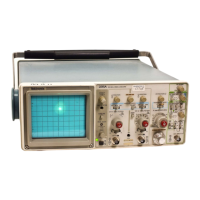Theory of Operation—2215A Service
GENERAL DESCRIPTION
NOTE
When reading this general circuit description o f the
2215A Oscilloscope, refer to the basic block diagram
(Figure 9-4) and to the detailed block diagram (Figure
9-5) located in the ‘Diagrams’ section o f this manual.
In Figures 9-4 and 9-5, the numbered diamond symbol
in each major block refers to the appropriate sche
matic diagram number.
Signals to be displayed on the crt are applied to either
the CH 1 OR X input connector or the CH 2 OR Y input
connector. These signals may be directly (DC) coupled to
the Attenuator circuit or ac (AC) coupled through an input
coupling capacitor. The input signals may also be discon
nected from the oscilloscope circuitry and the input
attenuator grounded by setting the coupling switch to the
GND position.
The output signal from the Attenuator circuit is applied to
the Vertical Preamplifier for further amplification. Addition
ally, the Channel 2 Attenuator can invert the Channel 2 dis
play on the crt. Trigger Pickoff Amplifiers in each channel
supply an internal trigger signal from either or both channels
to the Internal Trigger Amplifier.
Input signals are selected for display by the Channel
Switching circuit under control of the front-panel VERTICAL
MODE switches. The output signal from the Channel
Switching circuit is applied to the Delay Line Driver stage.
This stage converts a current input to a voltage output and
provides an impedance match for the Delay Line. The Delay
Line produces approximately 90 ns of delay in the vertical
signal. This allows the Horizontal circuitry time to start the
sweep so that the operator can see the signal that triggered
the sweep.
Final amplification of the vertical signal is performed by
the Vertical Output Amplifier. This Amplifier supplies the sig
nal levels necessary for vertical deflection of the electron
beam in the crt. The upper frequency response of the Ampli
fier can be reduced by enabling the Bandwidth Limit cir
cuitry. For locating the position of off-screen displays, the
dynamic range of the Amplifier can be limited with the Beam
Find circuitry. This circuitry also intensifies the trace and
limits horizontal deflection.
The A/B Sweep Separation circuitry supplies a dc-offset
current to the Vertical Output Amplifier which vertically posi
tions the B trace with respect to the A trace when Alt Hori
zontal Mode is selected.
The A Trigger circuitry uses either an Internal Trigger sig
nal, an External Trigger signal, or a Line Trigger signal ob
tained from the ac power line to develop the gate signal for
the A Sweep Generator. The B Trigger circuitry uses only
the Internal Trigger signal to gate the B Sweep Generator. A
P-P Auto Trigger circuit ensures that the range of the
A TRIGGER LEVEL control tracks the peak-to-peak ampli
tude of the trigger signal when either the P-P Auto or TV
Field trigger mode is selected. This allows triggering on
most signals without needing to adjust the A TRIGGER
LEVEL control. In Norm mode, the A TRIGGER LEVEL con
trol must be adjusted for the correct trigger signal level be
fore a sweep can be generated.
A TV Field sync circuit provides stable triggering on tele
vision vertical-sync pulses. Triggering at the television line
rate is accomplished when either P-P Auto or Norm mode is
selected.
The A Sweep Logic circuit controls sweep generation
and Z-Axis unblanking for the A Sweep display. When the
A TRIGGER Mode switches are set to either P-P AUTO or
TV FIELD and no trigger signal is present, the Auto Baseline
circuit causes the Sweep Logic circuit to produce a sweep
for reference purposes. In the NORM setting, the Auto
Baseline circuit is disabled and sweeps are inhibited until a
trigger event occurs. This is useful for triggering on low-
repetition-rate signals. The SGL SWP setting enables only
one sweep to be generated after being reset. Following the
single sweep, the A Trigger circuit is disabled until the SGL
SWP RESET button is pressed again.
The A Sweep Logic circuit controls the operation of the
A Miller Sweep Generator circuit. The Sweep circuit pro
duces a linear sweep output with a ramp time that is con
trolled by the A SEC/DIV switch. The sweep signal is
applied to the Horizontal Preamplifier for initial amplification
and then to the Horizontal Output Amplifier to drive the crt
horizontal deflection plates.
The Horizontal Preamplifier gain is increased by a factor
of 10 when the X I0 Magnifier is used. Horizontal positioning
of the display is accomplished in the Horizontal Preamplifier
circuit.
In the X-Y mode of operation, the Channel 1 signal from
the Internal Trigger circuitry passes through the X-Y Ampli
fier to the Horizontal Preamplifier. In this operating mode,
the Channel 1 Internal Trigger signal supplies the horizontal
deflection to the crt, and the Miller Sweep circuit is disabled
to inhibit sweep generation.
3-2

